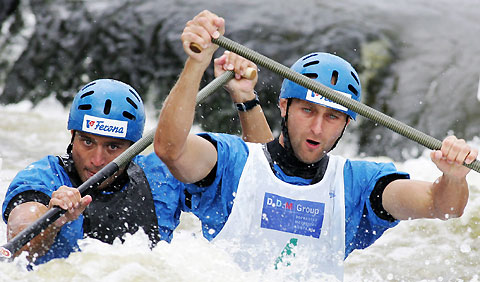 Olympic Sport since 1972
Olympic Sport since 1972
A whalebone and driftwood frame, with a sea-lion skin stretched tautly over
it and waterproofed with whale fat, hardly suggests a budding Olympic sport. Yet
the kayaks that meant life to the Inuits in the Arctic for centuries have become
the racing kayaks of the modern world - even if the building materials have
changed.
|
 |
|
Czech
Republic's Jaroslav Volf (R) and Ondrej Stepanek compete to win the C2 men
race at the ICF Canoe/Kayak Slalom Racing World Championships 2006 in
Prague August 5, 2006. [Reuters] |
The link
was 19th century British barrister John MacGregor. He studied the ancient
kayaks, designed a similar boat and disappeared into the rivers and lakes of
Europe's wilderness to become a noted travel writer of his time. When others
copied his boat, he founded the Royal Canoe Club, and canoe regattas began a
year later in 1866.
The sport reached the Olympic Games in 1924. Almost half a century later, in
Munich in 1972, canoe/kayak branched out into the dramatic whitewater version,
the slalom.
COMPETITION
The slalom events, involving men's K1, C1 and C2 and women's K1 (denoting one
or two paddlers in a canoe or kayak), require the paddlers to negotiate 20 to 25
gates in turbulent water over a 300-metre course. Competitors aim to complete
the course in the shortest time, factoring in penalties.
|
Men |
Women |
|
C-1 (canoe single)
C-2 (canoe double)
K-1
(kayak single) |
K-1 (kayak single)
|